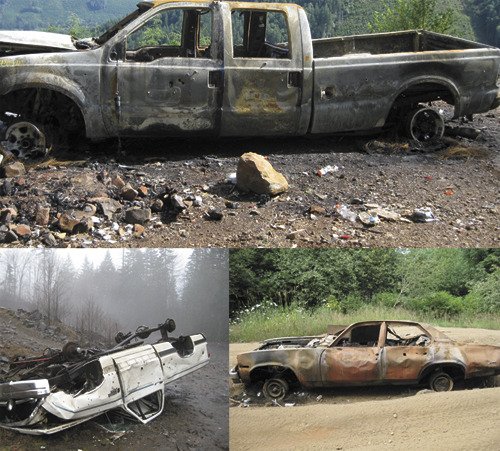The Washington State Department of Natural Resources (DNR) Thursday announced a new interactive online map showing locations of more than 200 sites that experienced illegal dumping last year on Washington state trust lands.
DNR, along with the Department of Ecology and other agencies, spend hundreds of thousands of dollars each year to clean up household trash, junked vehicles, and commercial and hazardous waste dumped illegally on state trust lands.
“This is only the tip of the iceberg,” said Larry Raedel, DNR’s Chief of Law Enforcement Services. “For every one of the sites we investigated, mapped and cleaned up last year, there are two or three more out there that we haven’t found yet.”
Illegal dumping often occurs near forest roads on the 2.1 million acres of forestland that DNR manages to generate revenue for public schools and local services in counties. Hazardous sites, such as discarded industrial solvents or meth labs, can cost thousands of dollars each to clean up. Sending trucks to remote locations to remove abandoned vehicles also is costly.
Raedel says the new online map is intended to show the extent of illegal dumping on state trust lands. The map shows locations of the 49 abandoned vehicles, 32 commercial and hazardous waste dumps, and 113 household dumping sites that DNR’s Law Enforcement Service investigated in 2010.
“We’re putting hidden cameras and sensors at known trouble spots to try and catch more people,” Raedel said. “Unfortunately, the majority of offenders are never caught, which is why we need law-abiding citizens to help us out.”
Funds from the Department of Ecology and other sources help pay for some clean-up costs as well as pay for prevention steps such as placing hidden cameras at likely dump sites and paying overtime to officers to conduct emphasis patrols. Courts may order those convicted of littering to pay clean-up costs.
“We are asking folks who use state lands to please report suspicious activities in the woods,” Raedel said, adding that illegal dumping also has a costly impact on private landowners and local governments. “Call 911 when suspicious activity is spotted.”
Arrests have occurred when campers or hunters noted the license tag numbers of pickup trucks driving into the woods with a load of garbage or other debris and coming out later with an empty pickup bed.
The fines for illegal dumping of non hazardous materials range from $90 to $500, depending on the quantity and other circumstances.The direct Web link to the map of illegal dumping on state trust lands is http://www.dnr.wa.gov/RecreationEducation/Topics/OtherNeighborQuestions/Pages/illegaldumping.aspx .
View photos of several illegal dump sites found on state trust lands on DNR’s Flickr page at http://www.flickr.com/photos/wastatednr/sets/72157625855775366/with/5367896587/ .






